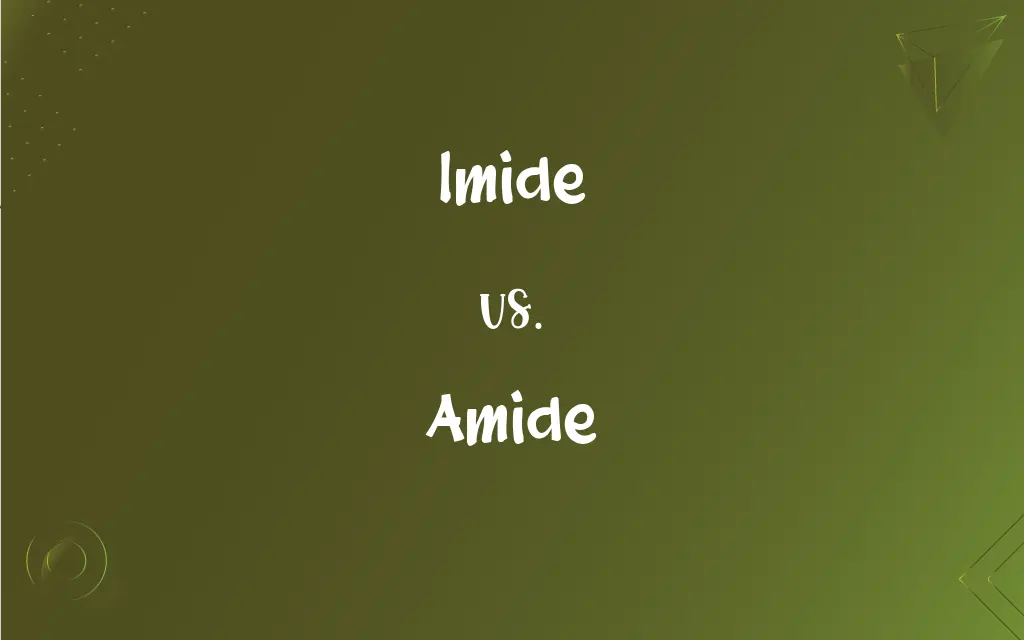Imide vs. Amide: What's the Difference?
By Janet White & Harlon Moss || Published on November 6, 2024
Imides are derived from two carboxylic acids with an N atom between, while amides form from an acid and amine, featuring a single carbonyl group.

Key Differences
Imides and amides are both functional groups in organic chemistry but differ in their structures and origins. Imides are derived from the reaction of two carboxylic acid molecules with an amine or ammonia, resulting in a compound with two carbonyl (C=O) groups attached to a nitrogen atom. Amides, on the other hand, are formed from a single carboxylic acid and an amine or ammonia, featuring only one carbonyl group bonded to a nitrogen atom.
The structural distinction between imides and amides is significant for their chemical properties and reactivities. Imides, with their two carbonyl groups, tend to be more rigid and have higher melting points compared to amides. This rigidity influences their applications, making imides suitable for high-performance materials. Amides are more flexible due to their single carbonyl group, which affects their solubility and makes them common in nature, as seen in proteins.
In terms of acidity, imides generally exhibit stronger acidic properties than amides. This is because the nitrogen atom in imides is more positively charged due to the influence of two adjacent carbonyl groups, making the hydrogen atoms more acidic. Amides, with only one carbonyl group, have less acidic hydrogens, making them less reactive in acidic conditions.
The applications of imides and amides also differ widely. Imides are often used in the manufacture of high-strength polymers, nylons, and synthetic fibers due to their thermal stability and mechanical strength. Amides, with their varied structures, are found in a wide range of applications from pharmaceuticals to polyamides like nylon, highlighting their versatility.
Despite their differences, both imides and amides play crucial roles in organic chemistry and material science. Their unique structures and properties make them indispensable in various chemical syntheses and industrial applications, from creating durable plastics to developing new medications.
ADVERTISEMENT
Comparison Chart
Structure
Contains two carbonyl (C=O) groups bonded to a nitrogen (N) atom
Contains one carbonyl (C=O) group bonded to a nitrogen (N) atom
Origin
Derived from two carboxylic acids and an amine or ammonia
Formed from one carboxylic acid and an amine or ammonia
Acidity
Generally more acidic due to the presence of two carbonyl groups
Less acidic because of the single carbonyl group
Applications
Used in high-strength polymers and materials
Found in pharmaceuticals, polyamides like nylon
Solubility and Melting Point
Tend to have higher melting points and specific solubility
More variable solubility, often used in nature
ADVERTISEMENT
Imide and Amide Definitions
Imide
Imides have a nitrogen atom connected to two carbonyl groups.
Phthalimide is used in the Gabriel synthesis of primary amines.
Amide
Amides have less acidic hydrogens, making them less reactive.
Benzamide is less acidic than benzoic acid.
Imide
Imides exhibit higher acidity due to electron-withdrawing carbonyl groups.
Succinimide is used in organic synthesis due to its acidic nature.
Amide
Amides are more flexible, affecting their solubility.
Dimethylformamide is a polar solvent used in the chemical industry.
Imide
Imides are known for their thermal stability.
Polyimides are used in high-temperature applications.
Amide
Amides are prevalent in biology and materials.
Nylon, a polyamide, is used in textiles.
Imide
Imides are used in high-performance materials.
Kapton, a polyimide, is used in flexible electronics.
Amide
Amides can undergo nucleophilic acyl substitution.
Amide hydrolysis in acidic conditions yields a carboxylic acid.
Imide
An acidic organic compound containing two carbonyl groups bonded to ammonia or to a primary amine.
Amide
Amides consist of a nitrogen atom attached to a single carbonyl group.
Acetamide is used as a solvent and in organic synthesis.
Imide
A strongly basic anion, NH2-, or a salt containing it.
Amide
An organic compound, such as acetamide, containing the CONH2 group.
Imide
(organic chemistry) a form of amide in which the nitrogen atom is attached to two carbonyl groups - R1CONHCOR2
Amide
The anion of ammonia, NH2- or a compound containing this anion, such as sodium amide, NaNH2.
Imide
A compound with, or derivative of, the imido group; specif., a compound of one or more acid radicals with the imido group, or with a monamine; hence, also, a derivative of ammonia, in which two atoms of hydrogen have been replaced by divalent basic or acid radicals; - frequently used as a combining form; as, succinimide.
Amide
(organic chemistry) Any derivative of an oxoacid in which the hydroxyl group has been replaced with an amino or substituted amino group; especially such derivatives of a carboxylic acid, the carboxamides or acid amides
Imide
Any of a class of organic compounds that contain the divalent radical -CONHCO-
Amide
(inorganic chemistry) Any ionic derivative of ammonia in which a hydrogen atom has been replaced with a metal cation (R-NH- or R2N-) Category:en:Nitrogen
Imide
Imides undergo nucleophilic attack at the carbonyl carbon.
Imide hydrolysis produces carboxylic acids.
Amide
A compound formed by the union of amidogen with an acid element or radical. It may also be regarded as ammonia in which one or more hydrogen atoms have been replaced by an acid atom or radical.
Amide
Any organic compound containing the group -CONH2
FAQs
What makes imides more acidic than amides?
Imides are more acidic due to the electron-withdrawing effect of two carbonyl groups, which increases the positive charge on the nitrogen, making the hydrogens more acidic.
Can amides be converted into imides?
Yes, through chemical reactions involving carboxylic acids, amides can be converted into imides, typically requiring dehydrating agents or other specific conditions.
Can both imides and amides form polymers?
Yes, both can form polymers; imides form high-strength polymers like polyimides, while amides form polyamides like nylon.
Are imides used in pharmaceuticals?
Imides are used in pharmaceuticals, although less commonly than amides. Some imide compounds have biological activity and are used in medication formulations.
How does the structure of imides and amides affect their applications?
The rigid structure of imides makes them suitable for high-performance materials, whereas the flexibility of amides allows for a wide range of applications from textiles to pharmaceuticals.
How do imides and amides participate in hydrogen bonding?
Amides can participate in hydrogen bonding due to the N-H bond, making them more soluble in water. Imides, with their more acidic H, might also engage in hydrogen bonding but to a different extent.
Are imides found in nature?
Imides are less common in nature than amides, which are widely present in proteins and other natural compounds.
Can imides and amides be synthesized from each other?
While direct conversion is uncommon, both imides and amides can be synthesized through multi-step processes involving carboxylic acids, amines, and specific reaction conditions.
What is the significance of the carbonyl group in imides and amides?
The carbonyl group significantly influences the chemical reactivity and physical properties of imides and amides, with its electron-withdrawing nature increasing acidity in imides and affecting the hydrogen bonding in amides.
How do the solubility properties of imides and amides differ?
Imides tend to be less soluble in water due to their rigid structure and double carbonyl groups, whereas amides, with potential for hydrogen bonding, often show greater solubility.
What are the safety considerations when handling imides and amides?
Safety depends on the specific compound, but generally, handling requires precautions to avoid exposure to toxic or irritating effects, especially with more reactive or volatile compounds.
How does the thermal stability of imides compare to that of amides?
Imides generally exhibit higher thermal stability than amides due to their rigid structure, making them suitable for applications requiring high-temperature resistance.
What is the environmental impact of imides and amides?
The impact varies widely depending on the specific compounds and their applications. Some polyamides like nylon are persistent in the environment, while certain imides and amides may be biodegradable.
Are there specific catalysts that favor reactions involving imides or amides?
Yes, certain catalysts, such as acids, bases, or organometallic compounds, can specifically facilitate reactions involving imides or amides, depending on the desired chemical transformation.
Can imides be used as intermediates in organic synthesis?
Imides serve as valuable intermediates in organic synthesis, particularly in the preparation of amines and other nitrogen-containing compounds through various chemical reactions.
What are the biodegradation pathways for amides in nature?
Amides can be biodegraded through enzymatic hydrolysis, breaking down into carboxylic acids and amines, which are then further metabolized by microorganisms.
What role do amides play in biology?
Amides are crucial in biology, forming the peptide bonds that link amino acids in proteins, thus playing a key role in the structure and function of living organisms.
How do chemical modifications affect the properties of imides and amides?
Chemical modifications, such as substituent changes, can significantly alter the physical and chemical properties of imides and amides, affecting solubility, reactivity, and potential applications.
How do imides and amides react with bases?
Amides can react with strong bases to form carboxylate salts and amine or ammonia, while imides might require harsher conditions for deprotonation due to their higher acidity.
How does the reactivity of imides compare to that of esters and acids?
Imides are generally less reactive than esters and acids due to the resonance stabilization of the nitrogen atom within the imide group, affecting nucleophilic attack rates.
About Author
Written by
Janet WhiteJanet White has been an esteemed writer and blogger for Difference Wiki. Holding a Master's degree in Science and Medical Journalism from the prestigious Boston University, she has consistently demonstrated her expertise and passion for her field. When she's not immersed in her work, Janet relishes her time exercising, delving into a good book, and cherishing moments with friends and family.
Co-written by
Harlon MossHarlon is a seasoned quality moderator and accomplished content writer for Difference Wiki. An alumnus of the prestigious University of California, he earned his degree in Computer Science. Leveraging his academic background, Harlon brings a meticulous and informed perspective to his work, ensuring content accuracy and excellence.







































































